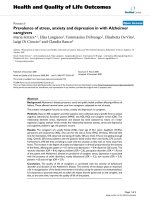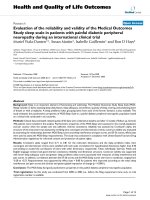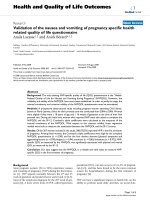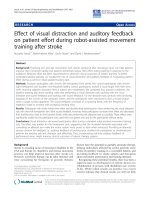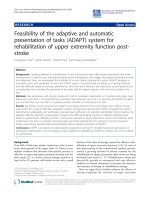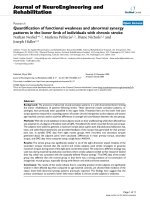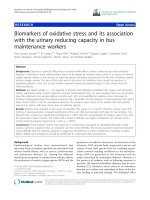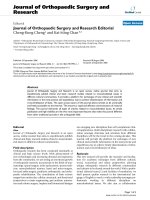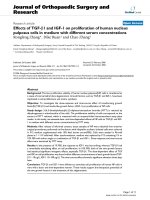Báo cáo hóa học: " School of Design, Engineering and Computing, " potx
Bạn đang xem bản rút gọn của tài liệu. Xem và tải ngay bản đầy đủ của tài liệu tại đây (509.75 KB, 2 trang )
EURASIP Journal on Wireless Communications and Networking 2005:1, 1–2
c
2005 Hindawi Publishing Corporation
Editorial
Anthony C. Boucouvalas
School of Design, Engineering and Computing, Bournemouth University, Fern Barrow, Poole, Dorset BH12 5BB, UK
Email:
Seamless integration of the technology into products which
are used in our daily life, products we rely on for necessary
common daily tasks, is a trademark of a mature and success-
ful technology.
It is not often that we think of optical wireless communi-
cations (OWC) with indoor optical links within remote con-
trol units as invisible extensions to our hands used to control
our daily home entertainment and other appliances while we
sit and relax comfortably in our settee. OWC is a relative
newcomer ubiquitous technology entering our homes in a
similar manner as other hugely successful and more mature
technologies such as motors and microprocessors.
There is wide diversity in the field of OWC applications
which span from very short-range (mm range) optical in-
terconnects within integrated circuits for clock distribution,
for example, to high-volume ubiquitous consumer electronic
products, to outdoor intrabuilding links of a few-kilometre
range, and to high-performance unique links of extreme-
range (45000 km) intersatellite links.
Prior to the development of fibre optics as the most suc-
cessful optical waveguide, wireless point-to-point communi-
cations using optical pipes with lenses were extensively being
studied at Bell Laboratories. The subsequent development
and growth of low-cost fibre optic components have further
facilitated OWC to complement fibre-optic links.
OWC are in use today in many diverse applications and
are tailored to offer low- and very-high-speed wireless links
cost effectively.
In common with other technologies within systems, their
growth depends on the user problems it successfully solves,
techno-economic issues, and developments/breakthroughs
in constituent component technologies.
Possible OWC successful applications are numerous,
spanning from payment systems, TV remote controls, and
infrared data association (IrDA) ports for watches, printers,
laptops, and mobile phones to last-mile broadband access,
easy-to-set-up TV broadcasting links, intersatellite links, and
deep-space links.
For high-volume consumer applications, the require-
ments and issues are for low-cost, short-range, high-dynam-
ic-range links and robustness to ambient noise, interference,
and availability of standards to allow interoperability be-
tween products.
The computer industry first pioneered through the IrDA
standards for short-range optical wireless data links for
computers. The first IrDA standard actually used technol-
ogy which evolved from the success of the early HP pro-
grammable calculators. The main purpose of those standards
is to offer low-cost and reliable connectivity between devices.
IrDA has produced standards for 115.2 kbps, 4 Mbps, and
16 Mbps optical wireless links and is currently developing for
100 Mbps and beyond. IEEE 802.11 has also produced a wire-
less LAN specification for optical wireless PHY.
Indoor remote control and interdevice connectivity has
therefore proven to be a fertile market for OWC.
Indoor optical wireless products must comply not only
with cost and usability constraints, but also with eye-safety
constraints which are now an integral part of the overall sys-
tem design. Eye safety in all situations is very important, and
operating within the safety margins as specified by IEC regu-
lations and other county regulations can be a frustrating and
often costly consideration.
Short-r ange OWC links are usually power-budget lim-
ited, and techniques to improve this are widely researched.
Indoor links operate in a highly variable ambient noise en-
vironment and importantly require receiver operation over
a very large dynamic range, from near contact with another
user to a maximum specified distance. It is hard to design
low-cost receivers and systems of a very high dynamic range
and high sensitivity. Most often, delicate engineering com-
promises come into play.
The understanding of the free-space communication
channel (indoors/outdoors) intricacies is essential for the
overall system development. Ambient light noise generated
by proximity to various types of room lights or the sunlight
fluctuates significantly, it also has v ariable optical and RF
spectra and results in variable noise and interference at the
receiver. Due to the unregulated nature of the optical radia-
tion, interference could also occur from other products radi-
ating IR such as TV remote controls or IR music headphones,
or from neighbouring users, if there is no effective medium
access control.
2 EURASIP Journal on Wireless Communications and Networking
Outdoor terrestrial OWC over a few-kilometer links have
been demonstrated at multi-Gbps data rates. In general, they
are subject to different challenges since the mode of opera-
tion is different and the “channel” is subject to severe weather
fluctuations as fog, snow, and rain via light scattering affect-
ing prominently the power budget. Depending on location,
links could be influenced by the position of the sun if it comes
within the receiver’s field of view. The challenge is very much
the attainment of 99.999% link availability (lately in hybrid
form with microwave links) at very high data rates under
all weather conditions and building sway. The links are opti-
mised for fixed locations, and high receiver sensitivity is de-
sired with a narrow optical beam delivered usually by Fresnel
lenses or other high-gain and directivity “optical antennas.”
Intersatellite and deep-space links, usually of less than
100 Mbps data rate, require very-high-power laser sources
and high-sensitivity receivers perhaps operating within a
few dB from theoretical capacity limits coupled with top-
quality optical lenses and narrowbeam tracking systems.
Component operation in vacuum and subzero temperature
is normal. In order to extend the OWC link range, fibre-
optic amplified transmitters and fibre-optic preamplifier at
the receiver, coupled with external optical Mach-Zehnder
modulators, advanced power-efficient encoding techniques,
forward-error correction, and perhaps coherent receivers, are
used.
Forming a network outdoors can be achieved via a series
of links used as hops, while indoors in a room LANs can be
formed via multiple reflections from walls and ceilings and
allow data reception from most locations in the room from
any transmitter via diffuse IR. This user-model designs rely
on the emitted radiation being diffused from reflections in
a uniform manner from walls and ceilings. This is not easily
achieved considering reflection losses, and at present, there
are a number of future proposals for multibeam diffusers
and receiver diversity techniques for improving the perfor-
mance of such systems without sacrificing too much band-
width. The cost of such systems is higher and is an important
consideration ($50–$400).
Diffuse optical links require more transmit optical power
than line-of-sight links. Since optical power is constrained
by eye safety , power efficient and bandwidth modulation
schemes are desirable and are the topic of intense research.
The first two papers in this special issue concentrate on
modulation schemes. The first paper presents a novel hybrid
differential amplitude pulse-position modulation (DAPPM)
which offers better bandwidth and/or power efficiency than
PAM, PPM, or DPPM, and the second pap er presents a SER
and BER analysis of a new hybrid PIM-CDMA technique.
The third paper also studies modulation to jointly can-
cel the multipath dispersion and fluorescent light noise in IR
CDMA systems. The authors show a tenfold improvement
in the BER for a given SNR and processing gain due to the
adaptive filter.
The fourth paper is a study on developing a transceiver
capable of operating in both line-of-sight and diffuse con-
figurations, utilising two-dimensional arrays of IR light-
emitting devices and photodetectors.
The fifth paper examines the concept of an optical wire-
less sensor network using corner cube retroreflectors (CCRs).
The sensors are interrogated using an optical beam, the re-
flection of which from the CCR is modulated by the CCR by
the parameter to be measured. The pap er examines collective
and majority signal decision schemes.
The last paper in this special issue examines the per-
formance of TinyTP, a lightweight TCP protocol over IrDA
stacks.
In closing this introduction to the special issue, it remains
for me to thank the authors and reviewers for their efforts
and contribution in producing this special issue. I hope that
you enjoy it and that it could inspire more creative research
ideas in the important field of OWC.
Anthony C. Boucouvalas
Anthony C. Boucouvalas graduated with a
B.S. degree in electrical and elect ronic en-
gineering from Newcastle upon Tyne Uni-
versity in 1978. He received his M.S. and
D.I.C. degrees in communications engi-
neering in 1979 from Imper i al College,
where he also received his Ph.D. degree in fi-
bre optics in 1982. Subsequently, he joined
GEC Hirst Research Centre and became a
Group Leader and Divisional Chief Scien-
tist working on fibre optic components, measurements, and sen-
sors until 1987 when he joined Hewlett Packard (HP) Laboratories
as a Project Manager. At HP Labs, he worked in the areas of op-
tical communication systems, optical networks, and instrumenta-
tion until 1994 when he joined Bournemouth University. In 1996,
he became a Professor in multimedia communications and in 1999
became a Director of the Microelectronics and Multimedia Re-
search Centre. His current research interests span the fields of wire-
less communications, optical fibre communications and compo-
nents, multimedia communications, and human-computer inter-
faces where he has published over 200 papers. He has contributed
to the formation of IrDA as an industry standard and he is now
a Member of the IrDA Architectures Council contributing on new
IrDA standards. He is a Fellow of the Royal Society for the encour-
agement of Arts, Manufacturers, and Commerce and a Fellow of
IEE. In 2002, he became a Fellow of IEEE, for contributions to op-
tical fibre components and optical wireless communications. He is
a Member of the New York Academy of Sciences and ACM. He is an
Editor of the IEEE Wireless Communications Magazine and IEEE
Transactions on Wireless Networks, Associate Editorial Member for
the Wireless Communications and Mobile Computing Journal, and
Vice Chairman of the IEEE UK&RI Communications Chapter. He
is in the Organising Committee of the International Symposium on
Communication Systems Networks and Digital Signal Processing
(CSNDSP), and a Member of Technical Committees in numerous
conferences.

